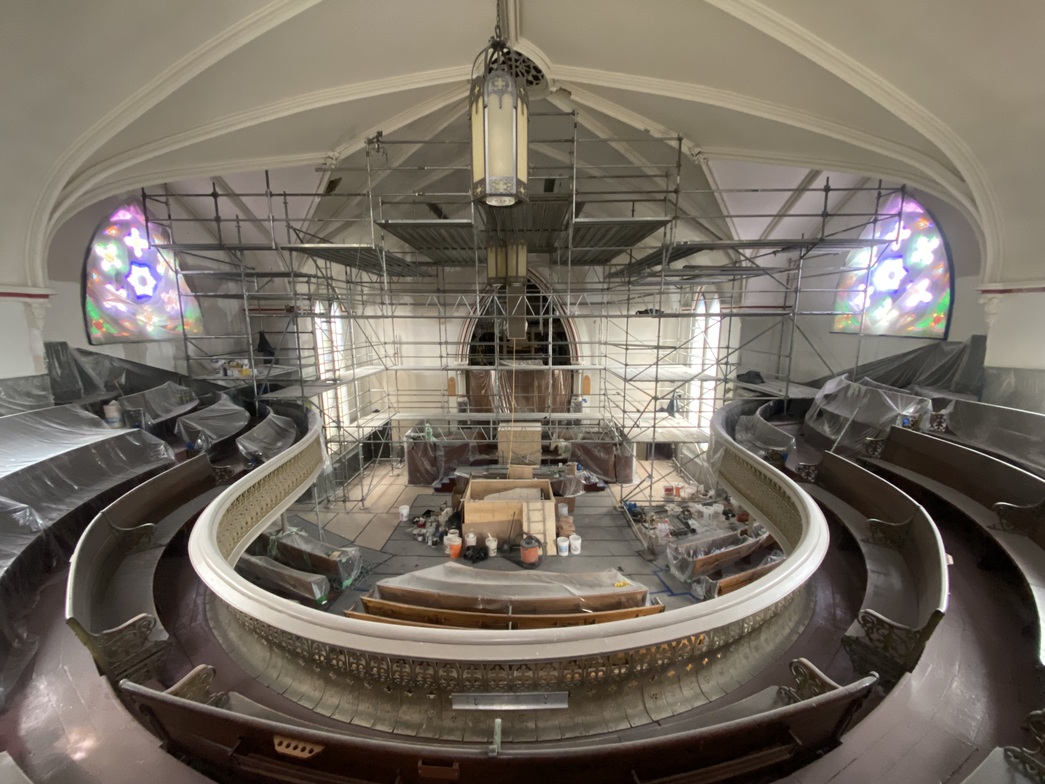Summary of Major Repairs Project


Dear Friends;
We have had a busy summer! Here are some of the highlights from the Major Repairs
Project, encompassing the roof of the Sanctuary and the plaster ceiling in the Sanctuary
and organ loft.
The Sanctuary was cleared out by several teams, with most items stored in Centennial
Hall, and some removed to the Parlour for holding services.
The removal of about 800 organ pipes was completed on schedule as the first stage of
the project, and the pipes were stored in Centennial Hall.
The scaffolding was brought in to the sanctuary within a few days of the completion of
the removal of the organ pipes. It was not necessary to bring it in through a window in
Centennial Hall, as predicted; Dan found a solution using the Centre St. doors.
Finance has been kept apprised of draws and cheque requisitions, and cheque
processing has been reasonably smooth.
We worked with the City, local Councillor Scott Thompson, and staff of the Heritage
Committee to work out a compromise on Heritage Designation for RHUC which we
were infom. Their initial requirement was that we should preserve the dormer vents on
the Sanctuary roof which we wanted to remove to prevent leaking. As a result of our
conversations these were removed form the list of attributes designated for
preservation.
The roof repairs were completed in July, very smoothly and on time. The closure of
Centre St. was uneventful. In addition to removal of the four dormers, several leaks and
holes were repaired. Minimal extra fees (about $800) were charged for these. The leak
at the point where the sanctuary roof meets the south tower has not been fixed, as the
flashing and sealant were found by Chouinard to be intact.
There are two outstanding water issues: one close to the former location of the
northwest dormer appears to be related to an animal nest; another significant leak has
been traced to the roof of Centennial Hall, where it meets the east wall of the sanctuary.
We are working with Dan on both these issues. We will soon be able to look at images
of the trouble spots on the roof, and on the towers, taken by a drone camera.
A “Substance Report” was required by HRI due to the suspected presence of asbestos
in repairs from a certain age of the building. The analysis indicated only special
precauitions to be observed when dealing directly with areas repaired or patched with
outdated material, as the amount of asbestos was very small. This was an extra cost,
but less than $1000.
The plaster contractor (Historic Restoration Inc.) have been very collaborative in terms
of independent and secure access to the building, and management of the smoke
alarms to prevent false reading from dust in the construction area. They also have kept
a clean site, and those who have used the Yonge St. access report to us that it is
effective and safe,
As advised by our expert piano tuner, the protective box around the piano has been
periodically opened up for airing the piano.
Our architectural consultants (ERA) were engaged to consult during the plaster repairs
and to verify stages of completion. Their services will cost $3-5000. They worked
closely with HRI on an issue that emerged with the decorative plaster ribs in the ceiling.
These ribs were found to be separating in several places from the wooden rafters to
which they have been secured by anchors set in the plaster. An engineering firm (WSP)
was engaged by HRI to advise on the best methods for re-securing plaster ribs where
they have become partially detached. The study by the engineering firm will cost about
$12,000. The additional cost of work by HRI to repair the rib attachments is not known
yet. As of today we and HRI are awaiting the engineering report.
Expected timing remains about the same; we hope to be able to use the Sanctuary by
Christmas, but it is hard to be precise. While HRI has made better than expected
progress, the delay caused by the need to re-secure the ribs is at least a few weeks.
Cleaning and replacement of the pipes is expected to require 45 days, after the ceiling
work is completed. During that time the sanctuary can be used, but the organ cannot be
played.
Costs:
We have used up a little less than half of the contingency fund of $40,000. Approximate
figures:
- WSP consulting, + 10% for HRI $12,000
- ERA consulting $4,000
- Substance test $1,000
- Extra leaks repaired by the roofer $1,000
- Drone photography $400
Thanks to everyone who has steered the project over the summer especially Dan, the
Finance team and Nava who have kept the payments in order, and DJ who has kept the
Board informed of our progress.
The Major Repairs Team – Ken Dunn, Carolyn Balant, Mark Baker, Doug Loweth and
Dan Plourde.
